India’s move to replace varying federal, state and interstate sales tax with a uniform Value Added Tax (VAT) makes a lot of sense (unlike Brazil which has high sales taxes and a 19% VAT).
Yet India should take care not to let the 17.3% tax rate creep up, because VAT too is subject to the “Laffer Curve.”
As the graph shows (using 2013 OECD data) the VAT never brings in revenue higher than 10% GDP even in countries that mistakenly raised the VAT to 20% or more — 23% in Greece and Ireland, 25% in Scandanavian countries, 26% in Iceland, 27% in Hungary. New Zealand collected 9.7% of GDP with a 15% standard VAT, while countries with much higher VATs brought in less.
No tax fails to inflict economic damage, of course, which holds down the revenue collected from income and payroll taxes. A study by James Alm of Tulane University and Asmaa El-Ganainy of the IMF found “a one percentage point increase in the VAT rate leads to roughly a one percent reduction in the level of aggregate consumption in the short run and to a somewhat larger reduction in the long run.” Such a reduction in consumer spending means fewer jobs, wages and profits, so a higher VAT leads to lower revenue from taxes on personal income and profits – a fact borne out by Japan’s experience.

